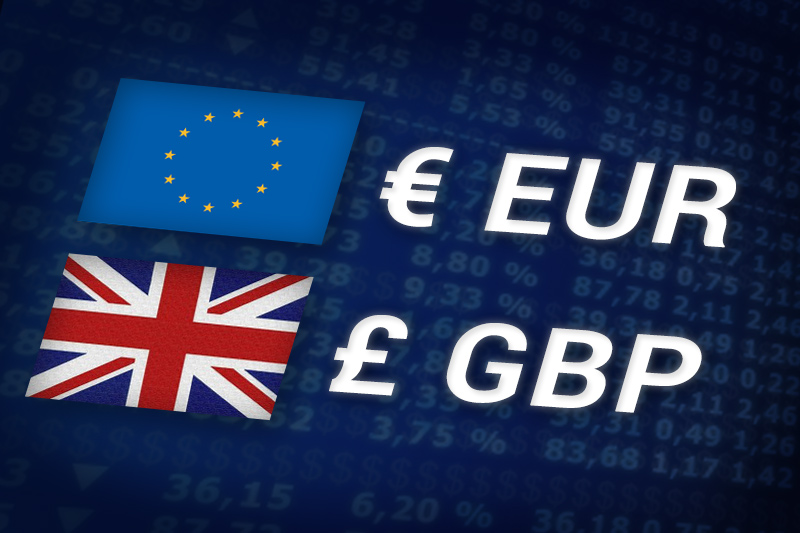Investing.com - The euro rose to a two-week high against the pound on Wednesday, following data showing that the U.K. manufacturing sector contracted more-than-expected in July, fuelling expectations for more easing from the Bank of England.
EUR/GBP hit 0.7874 during European morning trade, the pair’s highest since July 17; the pair subsequently consolidated at 0.7870, gaining 0.28%.
The pair was likely to find support at 0.7841, the session low and near-term resistance at 0.7875, the high of July 16.
The Markit/CIPS U.K. manufacturing purchasing managers' index dropped to 45.4 in July, the lowest level since March 2009, from a downwardly revised 48.4 in June and well below forecasts for a reading of 48.7.
The report said that output and new orders both contracted sharply amid weaker domestic and export demand. However, the report also said the employment index showed the first growth since April.
The weak data fuelled expectations for more monetary easing by the BoE in the coming months, after data last week showed that the U.K. economy contracted in the three months to June, extending the recession into a third quarter.
Earlier Wednesday, a report showed that U.K. house prices fell at the fastest annual rate in almost three years in July.
Mortgage lender Nationwide said house prices fell 0.7% in July and were down 2.6% year-over-year, the biggest annual decline since August 2009.
Sentiment on the euro remained fragile ahead of Thursday’s European Central Bank meeting, amid growing concerns that the bank will disappoint expectations for bold steps to counter the debt crisis in the euro zone.
Expectations have been mounting that the ECB will announce measures to lower Spanish and Italian borrowing costs after the bank’s head Mario Draghi pledged last week to do whatever is necessary to preserve the euro.
Market participants were also eying the outcome of the Federal Reserve’s policy setting meeting later in the day, amid speculation over whether the U.S. central bank will indicate if further quantitative easing measures are imminent.
The BoE was to hold its monthly rate setting meeting on Thursday, but was not widely expected to announce any change to existing monetary policy.
The pound was lower against the U.S. dollar, with GBP/USD down 0.20% to 1.5645.
Later Wednesday, the U.S. was also to release data on non-farm employment change, while the Institute for Supply Management was to produce a report on U.S. manufacturing activity.
EUR/GBP hit 0.7874 during European morning trade, the pair’s highest since July 17; the pair subsequently consolidated at 0.7870, gaining 0.28%.
The pair was likely to find support at 0.7841, the session low and near-term resistance at 0.7875, the high of July 16.
The Markit/CIPS U.K. manufacturing purchasing managers' index dropped to 45.4 in July, the lowest level since March 2009, from a downwardly revised 48.4 in June and well below forecasts for a reading of 48.7.
The report said that output and new orders both contracted sharply amid weaker domestic and export demand. However, the report also said the employment index showed the first growth since April.
The weak data fuelled expectations for more monetary easing by the BoE in the coming months, after data last week showed that the U.K. economy contracted in the three months to June, extending the recession into a third quarter.
Earlier Wednesday, a report showed that U.K. house prices fell at the fastest annual rate in almost three years in July.
Mortgage lender Nationwide said house prices fell 0.7% in July and were down 2.6% year-over-year, the biggest annual decline since August 2009.
Sentiment on the euro remained fragile ahead of Thursday’s European Central Bank meeting, amid growing concerns that the bank will disappoint expectations for bold steps to counter the debt crisis in the euro zone.
Expectations have been mounting that the ECB will announce measures to lower Spanish and Italian borrowing costs after the bank’s head Mario Draghi pledged last week to do whatever is necessary to preserve the euro.
Market participants were also eying the outcome of the Federal Reserve’s policy setting meeting later in the day, amid speculation over whether the U.S. central bank will indicate if further quantitative easing measures are imminent.
The BoE was to hold its monthly rate setting meeting on Thursday, but was not widely expected to announce any change to existing monetary policy.
The pound was lower against the U.S. dollar, with GBP/USD down 0.20% to 1.5645.
Later Wednesday, the U.S. was also to release data on non-farm employment change, while the Institute for Supply Management was to produce a report on U.S. manufacturing activity.
